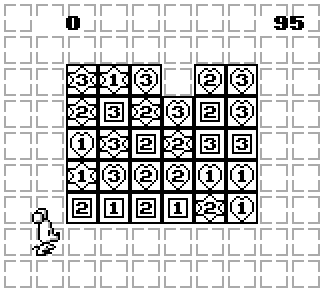
story |
gameplay |
my thoughts |
level structure |
controls |
options
BASIC INFO:Title ....... Q Billion (North America, Japan)
Players ..... 1-2
Genre ....... puzzle
Subgenre .... spatial reasoning
Platform .... Game Boy (1990)
 STORY:
STORY:You are a mouse in a house and you seek to get out. But in order to reach the outside, you must make your way through 30 rooms, each with a myriad of stacked boxes. Since you are an obsessive-compulsive mouse, and cannot leave a room that has stacked boxes, you must unstack all the boxes in order to leave the house. Silly mouse.
REAL STORY:None that I know of.
GAMEPLAY:
Q billion is a spatial reasoning game. You are presented with a puzzle in which there are several stacks of boxes. These boxes have numbers representing how tall these stacks are. Your goal is to reduce all stacks to 1 box high. However, there are limitations.
First, you can only push a stack that is 1 box tall.
Second, you can only topple a box that you are directly adjacent to; that is to say, if you want to topple the topmost box on a stack of 4 boxes, you must be sitting on a stack of 3 boxes next to it.
Finally, you cannot topple a stack of boxes, only the topmost box in a stack.

There is an additional mechanic with magical disappearing blocks, but that is explained better in-game than I could possibly do here.
All in all, this actually makes for a fun puzzle game. I haven't quite played anything else like it, which is a shame, as the game would play MUCH better with modern graphics (the game is presented with a top-down perspective, and the numbers on the boxes are quite nonsensical until you figure out the relationship between them). I'd love to play a sequel that looked like Picross 3D.
1 player mode has a GAME A and GAME B. There is also an editor for constructing your own 1 player puzzles.
GAME A presents you with a series of unique, one-room puzzles. Upon completing the 30th puzzle, you receive a password that unlocks 10 additional puzzles.

GAME B is a kind of versus mode that you play against the computer AI. Sorta. There are 5 "levels." Upon choosing a level, you are taken to a tic-tac-toe board, where you must choose 1 of the 9 squares, each of which represents a unique puzzle. If you solve the puzzle on this square quickly enough, you get to mark the board with your color. Your goal is to score 3 in a row, and then to win 5 "brackets." It's not all that exciting, except that you get 45 different puzzles out of it.
I have not been able to play using the 2 player mode, which I assume requires a second copy of the game, two Game Boys, and a link cable.
THOUGHTS:I consider this a hidden gem and a must-play for puzzler fans, particularly retro puzzler fans. This is quite fun and presents some very challenging puzzles.
However, I must note that the visuals are absolutely terrible, and it may take quite some time to figure out what they are trying to depict. This game would be much better with a rotatable isometric viewpoint. I'd love to see a rerelease for iOS or another modern platform.
The music is really obnoxious, too.
LEVEL STRUCTURE:GAME A has 40 levels. The first 30 are immediately accessible and the last 10 are unlocked with a password (received upon completing the 30th puzzle).
GAME B has 5 selectable "levels," each with 9 unique puzzles. No unlocking is necessary.
All puzzles are non-randomized.
CONTROLS:D-pad .... move cursor
select ... cancel out of a menu (in some places)
start .... choose menu item
A ........ (in puzzle) push block
B ........ (in puzzle) undo last move
OPTIONS:In GAME A, you can choose
slow, normal, or
fast. This controls how responsive the game is to your button presses. I prefer fast.
 STORY:
STORY:



 Q billion is a spatial reasoning game. You are presented with a puzzle in which there are several stacks of boxes. These boxes have numbers representing how tall these stacks are. Your goal is to reduce all stacks to 1 box high. However, there are limitations.
Q billion is a spatial reasoning game. You are presented with a puzzle in which there are several stacks of boxes. These boxes have numbers representing how tall these stacks are. Your goal is to reduce all stacks to 1 box high. However, there are limitations. There is an additional mechanic with magical disappearing blocks, but that is explained better in-game than I could possibly do here.
There is an additional mechanic with magical disappearing blocks, but that is explained better in-game than I could possibly do here. GAME B is a kind of versus mode that you play against the computer AI. Sorta. There are 5 "levels." Upon choosing a level, you are taken to a tic-tac-toe board, where you must choose 1 of the 9 squares, each of which represents a unique puzzle. If you solve the puzzle on this square quickly enough, you get to mark the board with your color. Your goal is to score 3 in a row, and then to win 5 "brackets." It's not all that exciting, except that you get 45 different puzzles out of it.
GAME B is a kind of versus mode that you play against the computer AI. Sorta. There are 5 "levels." Upon choosing a level, you are taken to a tic-tac-toe board, where you must choose 1 of the 9 squares, each of which represents a unique puzzle. If you solve the puzzle on this square quickly enough, you get to mark the board with your color. Your goal is to score 3 in a row, and then to win 5 "brackets." It's not all that exciting, except that you get 45 different puzzles out of it.
